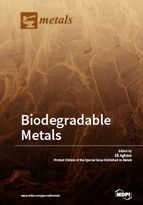Biodegradable Metals
A special issue of Metals (ISSN 2075-4701). This special issue belongs to the section "Biobased and Biodegradable Metals".
Deadline for manuscript submissions: closed (31 January 2018) | Viewed by 87525
Special Issue Editor
Special Issue Information
Dear Colleagues,
The interest in biocompatible and biodegradable metals, such as magnesium, is mainly related to their potential use as structural material for orthopedic and cardiovascular applications where a temporary medical device is required. However, in the case of magnesium, in vivo experiments have clearly shown that the corrosion degradation rate of magnesium and its alloys is too high and, hence, results in producing gas cavities that can promote the danger of gas embolism, tissue separation, and premature loss of mechanical integrity. The aim of this Special Issue on Biodegradable Metals is to explore and introduce innovative strategies to overcome the current limitations of magnesium. Papers relating to other potential biodegradable metals, such as Iron and Zinc, are also welcome.
Prof. Dr. Eli Aghion
Guest Editor
Manuscript Submission Information
Manuscripts should be submitted online at www.mdpi.com by registering and logging in to this website. Once you are registered, click here to go to the submission form. Manuscripts can be submitted until the deadline. All submissions that pass pre-check are peer-reviewed. Accepted papers will be published continuously in the journal (as soon as accepted) and will be listed together on the special issue website. Research articles, review articles as well as short communications are invited. For planned papers, a title and short abstract (about 100 words) can be sent to the Editorial Office for announcement on this website.
Submitted manuscripts should not have been published previously, nor be under consideration for publication elsewhere (except conference proceedings papers). All manuscripts are thoroughly refereed through a single-blind peer-review process. A guide for authors and other relevant information for submission of manuscripts is available on the Instructions for Authors page. Metals is an international peer-reviewed open access monthly journal published by MDPI.
Please visit the Instructions for Authors page before submitting a manuscript. The Article Processing Charge (APC) for publication in this open access journal is 2600 CHF (Swiss Francs). Submitted papers should be well formatted and use good English. Authors may use MDPI's English editing service prior to publication or during author revisions.
Keywords
- Magnesium
- Iron
- Zinc
- Biomaterials
- Implants
- Biocompatibility
- Biodegradable
- Bioabsorble
- Biocorrosion






